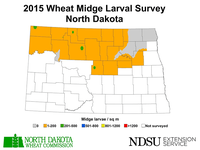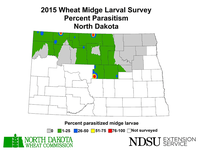Record Low N.D. Wheat Midge Populations Predicted for 2016
(Click an image below to view a high-resolution image that can be downloaded)
Soil samples in North Dakota indicate decreased levels of overwintering wheat midge larvae (cocoons) for the 2016 season, according to Janet Knodel, North Dakota State University Extension Service entomologist.
A total of 183 soil samples were collected from 20 counties in the fall of 2015 to estimate the regional risk for wheat midge in 2016. The distribution of wheat midge is based on unparasitized cocoons found in the soil samples.
“No soil samples were found with economic population densities of wheat midge (greater than 500 midge larvae per square meter) this past year,” Knodel says. “In fact, 74 percent of the soil samples had zero wheat midge cocoons. This is the lowest population of wheat midge ever recorded since we have been conducting the wheat midge larval soil survey, which started in 1995.”
Knodel adds, “This is good news for North Dakota wheat producers. It will reduce insecticide costs for wheat midge control in wheat in 2016.”
Wheat midge populations decreased by more than half from last year and ranged from zero to 429 midge larvae per square meter, with an average of 25 larvae per square meter in 2015. In 2014, wheat midge populations were higher, ranging from zero to 1,500 midge larvae per square meter, with an average of 61 larvae per square meter. In 2013, wheat midge populations were higher yet and ranged from zero to 3,285 midge larvae per square meter, with an average of 140 larvae per square meter.
“The highest wheat midge numbers ranged from 200 to 500 larvae per square meter in small, localized areas in southeast Burke, northwest Divide, north central Renville, west central Sheridan and northeast Ward counties,” says Knodel.
Wheat midge populations have declined sharply for several reasons, including multiple field reports of area wide insecticide-fungicide spraying for control of wheat midge and scab disease to minimize wheat losses, and the dry conditions when larvae dropped out of wheat heads in August, causing increased mortality.
Knodel adds, “It is always good insurance to scout for the orange flies at night when temperatures are greater than 59 F and the winds are less than 6 mph. Scout during the heading to early flowering crop stages.”
The economic thresholds are: one or more midge observed for every four or five heads on hard red spring wheat, or one or more midge observed for every seven or eight heads on durum wheat.
Producers also can use commercially available pheromone traps for monitoring wheat midge during heading. Traps should be placed at the height of the wheat heads during early heading. Use three traps per 160 acres of wheat. Traps are available for about $3 per trap.
After three to five days of monitoring with pheromone traps, an economic threshold is reached when an average of more than 10 midge are captured per trap.
Unfortunately, the parasitic wasp Macroglenes penetrans, which kills wheat midge eggs and larvae, also has decreased considerably from a 3.7 percent parasitism rate in 2015 to an 11 percent parasitism rate in 2014, according to Knodel. Ninety-one percent of the larval cocoons had zero incidence of parasitism in 2015, compared with 73 percent in 2014.
“This is because the parasitic wasp populations are dependent on their host populations, the wheat midge,” Knodel says. “So, when wheat midge declines, so does the parasitic wasp. This wasp plays an important role in keeping wheat midge controlled naturally.”
Parasitism rates ranged from zero to 100 percent across the state, with the higher rates occurring in areas where midge populations have been high during the past few years, such as Burke and Divide counties.
“We need to continue to conserve parasitic wasp populations when possible by spraying insecticides only when wheat midge populations are at economic threshold levels, and avoiding any late insecticide applications to minimize the negative impacts on parasitic wasps that are active at that time,"" Knodel says.
NDSU Extension Service agents collected the soil samples. The North Dakota Wheat Commission supports the wheat midge survey.
NDSU Agriculture Communication - Feb. 22, 2016
| Source: | Janet Knodel, (701) 231-7915, janet.knodel@ndsu.edu |
|---|---|
| Editor: | Kelli Armbruster, (701) 231-6136, kelli.armbruster@ndsu.edu |



